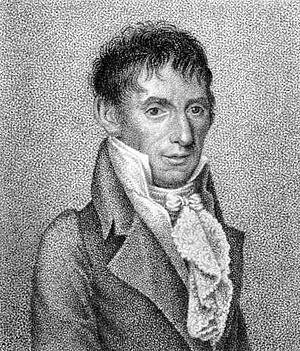Alessandro Rolla facts for kids
Quick facts for kids
Alessandro Rolla
|
|
|---|---|

Alessandro Rolla, Milan, c. 1820, on a stipple engraving by Luigi Rados (1773–1840).
|
|
| Background information | |
| Born | 23 April 1757 Pavia, Italy |
| Died | 14 September 1841 (aged 84) Milan, Italy |
| Occupation(s) | Composer |
Alessandro Rolla (born April 23, 1757 – died September 14, 1841) was a super talented Italian musician. He was amazing at playing the viola and violin, and he also wrote music, led orchestras, and taught others. His son, Antonio Rolla, followed in his footsteps as a great violin player and composer.
Many people know Rolla as the teacher of the famous musician Niccolò Paganini. But Rolla was important for more than just teaching Paganini! He actually invented many cool playing techniques that Paganini later made famous. These included plucking strings with the left hand (called left-hand pizzicato). He also introduced playing super high notes and fast, tricky scales on the violin and viola.
Contents
Life Story
Alessandro Rolla was born in Pavia, Italy, in 1757. After his first music lessons, he moved to Milan. There, from 1770 to 1778, he studied with Giovanni Andrea Fioroni. Fioroni was the main music director at Milan Cathedral.
In 1772, Rolla played his first public solo performance. He also showed off his own music. People at the time said he performed "the first viola concerto ever heard." A concerto is a piece of music for a solo instrument with an orchestra.
Leading Orchestras
In 1782, Rolla became the main viola player and leader of the Ducale Orchestra in Parma. He played both violin and viola there until 1802. In 1795, the father of a young Niccolò Paganini visited Rolla. He wanted Rolla to teach his talented son.
After the Duke of Parma passed away, Rolla got a new job in Milan. In 1802, he became the leader and director of the famous La Scala Orchestra. The new leaders of Milan wanted La Scala to have the best orchestra in Italy. So, they hired the most talented musicians of that time.
Teaching and Conducting
Rolla stayed at La Scala until 1833. He was known as the "First Violin, Head of the Orchestra." This meant he was in charge of leading the entire orchestra. He conducted the first performances in Milan of many famous operas. These included Mozart's Don Giovanni and The Marriage of Figaro. He also led Beethoven's first symphonies.
During this time, he also conducted about eighteen operas by Gioachino Rossini, a very popular opera composer. He also worked with composers like Gaetano Donizetti and Bellini. He even conducted the first performance of Bellini's famous opera Norma.
Music Education
From 1811, Rolla also directed a Cultural Society. Musicians there would play chamber music by composers like Haydn, Mozart, and Beethoven. Chamber music is played by a small group of instruments. In 1813, he gave private performances of Beethoven's 4th, 5th, and 6th symphonies at this society.
In 1808, the Conservatoire of Music in Milan opened. Rolla was made a professor of violin and viola there. For his students, he wrote many teaching pieces. These pieces were designed to get harder as students improved. Many of them were published by the new music company, Ricordi.
Musical Contributions
Even though opera was very popular in Italy, Rolla kept writing instrumental music. He helped keep Italy's tradition of instrumental music strong. He wrote about 500 pieces! These included teaching works, sonatas (pieces for one or two instruments), quartets (for four instruments), and symphonies (for a full orchestra). He also wrote many concertos for violin and at least 13 concertos for viola and orchestra.
Rolla helped spread Beethoven's music in Italy. His own music shows that he knew Beethoven's style well. He continued to compose and play chamber music until just a few months before he passed away at age 84.
Rolla's Legacy
Rolla's music was published by many companies across Europe. This shows how famous he was during his lifetime. He was a musician with a wide view, always trying new things in his field. He also learned from the best musicians of his time. Being so involved in opera also influenced his style. He often used themes from operas in his own music.
Many of his works are now published again, so musicians can still play them. His performances and compositions were often praised in music newspapers. Rolla deserves a more important place in viola music history. His teaching pieces, especially for the viola, are very helpful for students and teachers today. They are often written as duos, which are great for learning to play music with others.
His Unique Style
Rolla's music helped develop new ways of playing the viola. His style could be very melodic, like an opera song, with lots of fancy musical decorations. But it could also be extremely difficult and showy, like the style of Paganini.
His techniques included playing two notes at once (double stops) and fast passages of notes. He also used very fast scales, both simple (diatonic) and complex (chromatic). He even used a technique called "flying staccato" and plucking strings with the left hand (left-hand pizzicato). This intense, showy playing was new for the viola. One historian even wrote that Rolla was sometimes not allowed to play in public. This was because his music was so powerful, it made some people feel overwhelmed!

